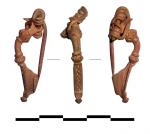Summary (English)
ARCHAEOLOGICAL EXPLORATIONS IN CONBUSTICA (Krassimira Luka – bularchaeo@gmail.com) In 1890, a rectangular fortress was documented. It was identified as the Roman mansio Conbustica, attested in the Tabula Peutingeriana and situated on the road between Ratiaria and Timacum Minus. The explorations revealed that the fortress measured 140 m by 110 m. Remains of a pottery kiln of the second half of the 3rd – 4th century AD and two necropoleis were documented near the fortress. A sondage, 5 m by 2 m in size, was carried out from the inner side of the eastern fortification wall. The foundation of the wall was 1 – 1.10 m deep and was constructed of cut stones. The wall is preserved up to 50 cm in height and was built of ashlars bonded with mortar. The finds include sherds from terra sigillata with North Italian and South Gaulish shapes (its latest date is the reign of Trajan), two fibulae of the end of the 1st – beginning of the 2nd century AD and Late Antique pottery of the second half of the 3rd – 4th centuries AD. The site dates from the second half of the 1st to the end of the 4th century AD. Probably, Conbustica was founded as a Roman military camp some time before the Dacian Wars of Emperor Trajan.
- Krassimira Luka - Department of Archaeology, Sofia University St. Kliment Ohridski
Director
Team
Research Body
- Sofia University St. Kliment Ohridski






![Download [PDF]](/excavation/skins/fasti/images/results/download_sml.png)
